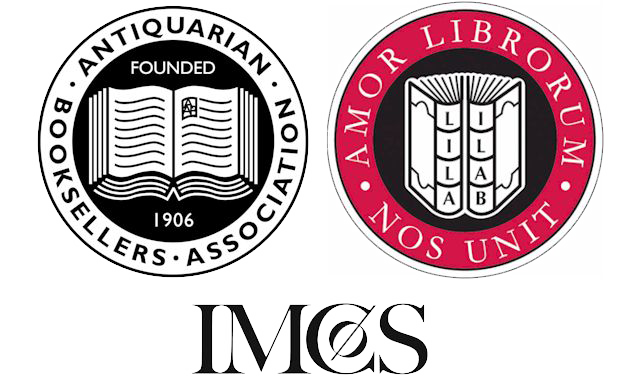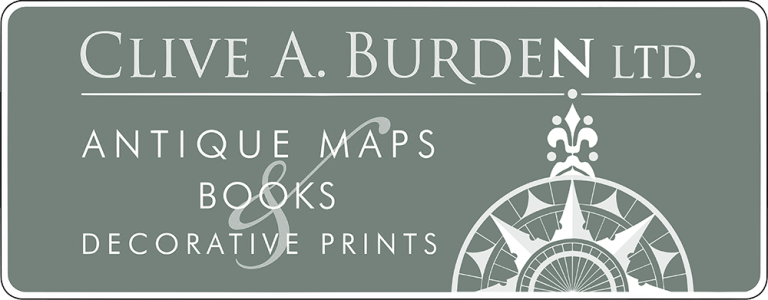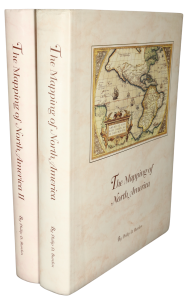Rare Maps and Prints
- World & Celestial
- North America
- West Indies, South & Central America
- British Isles
- British Isles
- English counties
- Large-scale
- Bedfordshire
- Berkshire
- Buckinghamshire
- Cambridgeshire
- Cheshire
- Cornwall
- Cumberland
- Derbyshire
- Devon
- Dorset
- Durham
- Essex
- Gloucestershire
- Hampshire
- Herefordshire
- Hertfordshire
- Huntingdonshire
- Islands
- Kent
- Lancashire
- Leicestershire
- Lincolnshire
- Middlesex
- Norfolk
- Northamptonshire
- Northumberland
- Nottinghamshire
- Oxfordshire
- Rutland
- Shropshire
- Somerset
- Staffordshire
- Suffolk
- Surrey
- Sussex
- Warwickshire
- Westmoreland
- Wiltshire
- Worcestershire
- Yorkshire
- Wales
- Scotland
- Ireland
- Western Europe
- Eastern Europe
- Middle East
- Africa
- Asia
- Australasia & Pacific
- Decorative Prints
- Title Pages
Mr. Philip D. Burden
P.O. Box 863,
Chalfont St. Giles, Bucks HP6 9HD,
UNITED KINGDOM
Tel: +44 (0) 1494 76 33 13
Email: enquiries@caburden.com
Including the FIRST PRINTED PLAN OF THE POSITIONS AT THE BATTLE OF BUNKER HILL. Extremely rare especially with the accompanying monthly issue of the Pennsylvania Magazine. There were only three magazines published in America between the period 1772 to 1783, the important period leading up to and during the American Revolution. Two were ‘The Royal Magazine’ issued in Boston 1774-75 and ‘The United States Magazine’ published in Philadelphia 1779. The most important however was ‘The Pennsylvania Magazine’ published in Philadelphia between January 1775 and July 1776 by Robert Aitken (1735-1802) and edited by Thomas Paine (1737-1809). The first issue in January 1775 sold six hundred copies and it was for the February issue that Paine was made editor. Through his work within a few months there were fifteen hundred paid subscribers. It was during his stewardship that he wrote and published ‘Common Sense’. He often wrote using the initials ‘A.B.’ or used the pseudonym ‘Atlanticus’. He remained editor until May 1776. It was the only magazine issued in the colonies during this critical period.
His most notable contribution in this issue is the first printing of the ‘LIBERTY TREE’ on pages 328 and 39. On 14 August 1765 two effigies were discover in the largest of a group of elm trees at orange and Essex Streets in Boston, now Washington and Essex. They were placed in protest against the Stamp Act imposed by the British. Over the years it became a symbol of liberty and numerous famous prints depict it. A month after Paine published the song in late August 1775 it was defiantly cut down by a group of loyalists led by Job Williams. It had been planted in 1649.
Aitken once described how best to get work from Paine when deadlines pressed. He would seat him at a table with a glass and a decanter of brandy “he would never write without that.” “The first glass put him in a train of thinking; Aitken feared the second would disqualify him, or render him untractable; but it only illuminated his intellectual system; and when he had swallowed the third glass, he wrote with great rapidity, intelligence, and precision; and his ideas appeared to flow faster than he could commit them to paper. What he penned from the inspiration of the brandy, was perfectly fit for the press without any alteration, or correction” (Thomas).
On pages 334-7 is John Hancock’s ‘A Declaration by the Representatives of the united Colonies of North-America, now met in the General Congress at Philadelphia, setting forth the Causes and Necessity of their taking up Arms’ issued on 6 July 1775. It was the resolution of the Second Continental Congress.
At the end of the magazine is an account of the battle of Bunker’s Hill with a list of the number of the dead. The accompanying folding plan of Boston entitled ‘A New and Correct Plan of the Town of Boston and Provincial Camp’ is engraved by Robert Aitken. The June issue of the magazine included a map which bore a legend beneath the title reading ‘NB Charlestown burnt June 17th. 1775 by the Regulars’ but bore no detail on the map. It was published just 2 or 3 days after the battle with little time to record detail on the plate beyond an additional note. It is this next month’s issue which gave to the opportunity to record more.
By June 1775 following the battles of Lexington and Concord some 10,000 militia from the colonies had poured in to the region and laid siege to the town of Boston held by the British. George Washington had only just been named Commander in Chief of these forces on 3 July 1775. The inset lower right illustrates General Gage’s position holding Boston Neck with the opposing Provincial Lines near Roxbury. The British Battery on Boston Common is shown on the main map and opposite Charles Town near Corpse Hill by the Ferry point. The Provincial Line extends from Winter Hill on the Mystick River to Cambridge noting five Forts. Ristow describes this map along with that in the issues of June and August as “the earliest revolutionary war maps printed in America”. It was issued before the news had even reached Britain.
Individual issues of the magazine are rare and often lack their accompanying maps and plates. A fascinating item of American Revolutionary interest. Provenance: Bill Reese Catalogue 208 item 4. Evans 14380; Jolly ‘Maps of America in Periodicals Before 1800’ no. 267; Mott (1930) ‘A History of American Magazines 1741-1850’; Nebenzahl (1975) 2 & 2a; Phillips Maps p. 10; Richardson (1931) ‘A History of Early American Magazines 1741-1789’ p. 163; Ristow (1985) p. 41; Thomas (1810) ‘The History of Printing in America’; Wheat & Brun 238.
His most notable contribution in this issue is the first printing of the ‘LIBERTY TREE’ on pages 328 and 39. On 14 August 1765 two effigies were discover in the largest of a group of elm trees at orange and Essex Streets in Boston, now Washington and Essex. They were placed in protest against the Stamp Act imposed by the British. Over the years it became a symbol of liberty and numerous famous prints depict it. A month after Paine published the song in late August 1775 it was defiantly cut down by a group of loyalists led by Job Williams. It had been planted in 1649.
Aitken once described how best to get work from Paine when deadlines pressed. He would seat him at a table with a glass and a decanter of brandy “he would never write without that.” “The first glass put him in a train of thinking; Aitken feared the second would disqualify him, or render him untractable; but it only illuminated his intellectual system; and when he had swallowed the third glass, he wrote with great rapidity, intelligence, and precision; and his ideas appeared to flow faster than he could commit them to paper. What he penned from the inspiration of the brandy, was perfectly fit for the press without any alteration, or correction” (Thomas).
On pages 334-7 is John Hancock’s ‘A Declaration by the Representatives of the united Colonies of North-America, now met in the General Congress at Philadelphia, setting forth the Causes and Necessity of their taking up Arms’ issued on 6 July 1775. It was the resolution of the Second Continental Congress.
At the end of the magazine is an account of the battle of Bunker’s Hill with a list of the number of the dead. The accompanying folding plan of Boston entitled ‘A New and Correct Plan of the Town of Boston and Provincial Camp’ is engraved by Robert Aitken. The June issue of the magazine included a map which bore a legend beneath the title reading ‘NB Charlestown burnt June 17th. 1775 by the Regulars’ but bore no detail on the map. It was published just 2 or 3 days after the battle with little time to record detail on the plate beyond an additional note. It is this next month’s issue which gave to the opportunity to record more.
By June 1775 following the battles of Lexington and Concord some 10,000 militia from the colonies had poured in to the region and laid siege to the town of Boston held by the British. George Washington had only just been named Commander in Chief of these forces on 3 July 1775. The inset lower right illustrates General Gage’s position holding Boston Neck with the opposing Provincial Lines near Roxbury. The British Battery on Boston Common is shown on the main map and opposite Charles Town near Corpse Hill by the Ferry point. The Provincial Line extends from Winter Hill on the Mystick River to Cambridge noting five Forts. Ristow describes this map along with that in the issues of June and August as “the earliest revolutionary war maps printed in America”. It was issued before the news had even reached Britain.
Individual issues of the magazine are rare and often lack their accompanying maps and plates. A fascinating item of American Revolutionary interest. Provenance: Bill Reese Catalogue 208 item 4. Evans 14380; Jolly ‘Maps of America in Periodicals Before 1800’ no. 267; Mott (1930) ‘A History of American Magazines 1741-1850’; Nebenzahl (1975) 2 & 2a; Phillips Maps p. 10; Richardson (1931) ‘A History of Early American Magazines 1741-1789’ p. 163; Ristow (1985) p. 41; Thomas (1810) ‘The History of Printing in America’; Wheat & Brun 238.
AITKEN, Robert
The Pennsylvania Magazine
R. Aitkin ... opposite the London Coffee-House, Front-Street, Philadelphia, July 1775
Octavo (205 x 130 mm.), lacking wrappers and clearly from a bound volume but with accompanying folding plan of the town Boston, toned as usual otherwise in good condition.
Stock number: 8908
SOLD








